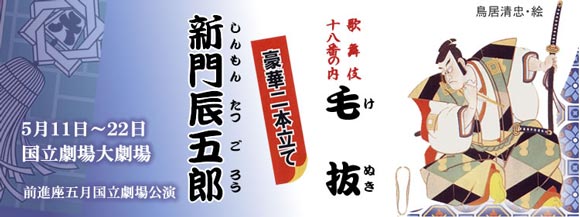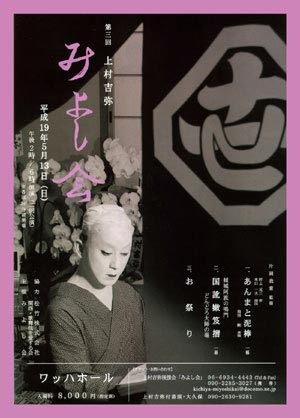| MAY 2007 |
|
5 shows in T˘ky˘ (Kabukiza, Shinbashi Enbuj˘, National Theatre), 1 in Ky˘to (Minamiza), 1 in ďsaka (Wahha Kamigata Engei Hall) and 1 tour (Chikamatsuza)!
|
| Kabukiza (T˘ky˘) |  |
| Dates | 1 ~ 25 May 2007 (Dankikusai Gogatsu ďkabuki) |
| MatinÚe |
Dorob˘ to Wakatono Yowa Nasake Ukina no Yokogushi (Kirare Yosa)
|
| Evening | |
| Casting |
Ichikawa Danjűr˘, Onoe Kikugor˘, Band˘ Mitsugor˘, Nakamura Shikan, Nakamura Tokiz˘, Nakamura Baigyoku, Ichikawa Danz˘, Ichikawa Sadanji, Nakamura Kanjaku, Ichimura Manjir˘, Band˘ Hikosabur˘, Ichikawa Ebiz˘, Onoe Kikunosuke, Onoe Sh˘roku, Ichikawa Monnosuke, Ichikawa Omez˘, Sawamura Tanosuke, Kataoka Ichiz˘, ďtani Tomoemon, Band˘ Shűch˘, Kataoka Kamez˘, Ichikawa Unosuke, Ichimura Kakitsu, Kawarasaki Gonjűr˘, Band˘ Kamesabur˘, Band˘ Kametoshi, Nakamura Toranosuke, Ichimaura Takematsu, Ichimura Hikaru |
| Comments |
This program celebrates the 120th anniversary of the first Kabuki performance given for the Emperor (the 21st of April 1887) with the dance-drama "Kanjinch˘" and the 6th anniversary (7th memorial service) of the death of Ichimura Uzaemon XVII witht the drama "Onna Shibaraku":
|
| Shinbashi Enbuj˘ (T˘ky˘) |
| Dates | 1 ~ 25 May 2007 (Gogatsu ďkabuki) |
| MatinÚe |
Onihei Hankach˘ (ďkawa no Inkyo) |
| Evening |
Imoseyama Onna Teikin |
| Casting |
Nakamura Kichiemon, Nakamura Shibajaku, Ichikawa Danshir˘, Nakamura Tomijűr˘, Nakamura Fukusuke, Ichikawa Somegor˘, Nakamura Kinnosuke, Nakamura Kash˘, Nakamura Karoku, Nakamura Kichinoj˘, Nakamura Matsue, Ichikawa Komaz˘, Nakamura Tamatar˘ |
| Comments |
Nakamura Kichiemon is for the second time the zagashira of a troupe of young actors performing at the Shinbashi Enbuj˘. He plays four major roles, including the role of Hasegawa Heiz˘, a role which he played for many years in the TV series "Onihei Hankach˘".
|
| National Theatre (T˘ky˘) |
| Dates | 11 ~ 22 May 2007 (Zenshinza Gogatsu K˘en) |
| Program |
Shinmon Tatsugor˘ |
| Casting |
Nakamura Umenosuke, Arashi Keishi, Kawarasaki Kunitar˘, Nakamura Baijaku, Segawa Kikunoj˘, Fujikawa Yanosuke, Arashi Hironari, Yamazaki Ryűnosuke, Yamazaki Ky˘ka, Yamazaki Tatsusabur˘, Osagawa Genjir˘ |
| Comments |
The Zenshinza troupe stages two of its classics, the bombastic Kabuki Jűhachiban drama "Kenuki" and Mayama Seika's shinkabuki drama "Shinmon Tatsugor˘":
|
 |
|
|
|||
| Dates | 9 ~ 23 May 2007 (Band˘ Tamasabur˘ Tokubetsu Buy˘ K˘en) | ||
| Program |
Okuni Kabuki Yume no Hanayagi |
||
| Casting |
Band˘ Tamasabur˘, Ichikawa Danjir˘, Ichikawa Emisabur˘, Ichikawa En'ya, Ichikawa Shun'en, Band˘ Shinsha |
||
| Chikamatsuza Tour | |
| Dates | 19 ~ 27 May 2007 |
| Program | |
| Casting | |
| Comments |
18th edition of the Chikamatsuza tour.
|
| Wahha Kamigata Engei Hall (ďsaka) | |
| Dates | 13 May 2007 (Miyoshi no Kai) |
| Program |
Anma to Dorob˘ |
| Casting | |
| Comments |
Third edition of the program of the association Miyoshi no Kai, which stars the young and talented actor Kamimura Kichiya, who plays the roles of the blind masseur Hide-no-Ichi and Oyumi in "Anma to Dorob˘" and "Keisei Awa no Naruto".
|
 |
|
|
|
| Contact | Main | Top | Updates | Actors | Plays | Playwrights | Programs | Links | FAQ | Glossary | Chronology | Illustrations | Prints | Characters | Derivatives | Theaters | Coming soon | News |